Stainless Steel Tactile Studs & Plates: A Complete Guide to Tactile Paving
4th Jun 2025
Stainless Steel Tactile Paving: Studs & Plates for Accessible Public Spaces
Ensure safety, accessibility, and compliance with durable stainless steel tactile paving solutions. Our range of tactile studs, plates, and directional bars helps visually impaired individuals navigate public spaces with confidence.
What Is Tactile Paving?
Tactile paving refers to textured ground surface indicators (TGSI) designed to assist visually impaired pedestrians. Detectable by foot or with a white cane, these indicators improve safety, mobility, and confidence in shared spaces.
In the UK, tactile paving installation follows the Department for Transport Guidance on the Use of Tactile Paving Surfaces. Compliance with ISO 23599:2023 ensures legal adherence, accessibility, and long-term durability.
- Provides clear cues for visually impaired users
- Enhances safety at crossings, platforms, and building entrances
- Supports inclusive public spaces in line with DDA and BS8300 standards
Where Is Tactile Paving Used?
Stainless steel tactile paving is ideal for high-traffic areas where durability and visibility are essential:
- Train, tram, and bus platforms
- Commercial and retail entrances
- Educational campuses
- Healthcare and aged care facilities
- Pedestrian crossings and shared-use zones
Why Choose Stainless Steel Tactile Paving?
- Rust-resistant and weatherproof: Perfect for outdoor and high-traffic areas
- Modern aesthetic: Complements contemporary architecture
- Durable and low-maintenance: Long-lasting performance with minimal upkeep
- Compliance-ready: Meets ISO 23599:2023, DDA, and BS8300 standards
Featured Stainless Steel Tactile Products
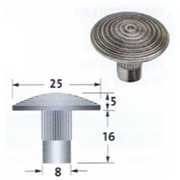
Individual domed studs for precise placement and high-traffic areas.
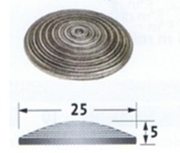
Easy adhesive installation for retrofit or new projects.
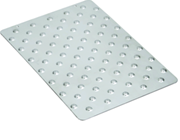
Modular panels for rapid coverage of larger areas.
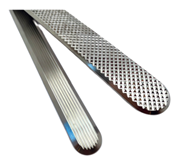
Directional corduroy bars for guiding pedestrians safely.
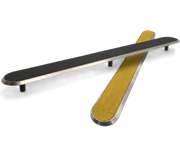
Enhanced grip for wet or outdoor environments.
Tactile Paving Comparison: Studs, Plates & Bars
Not sure which tactile paving product to choose? This comparison table highlights the key features, applications, and benefits of each type:
| Product Type | Key Features | Best For | Installation |
|---|---|---|---|
| Tactile Studs | Individual domed units, precise placement, detectable by foot/cane | Warning indicators at crossings, platforms, small areas | Mechanical fixing (stem) or adhesive |
| Tactile Plates | Modular panels, cover large areas quickly, consistent texture | Entrances, pedestrian zones, high-traffic pathways | Mechanical fixing (screws) or adhesive |
| Directional Bars / Corduroy Strips | Linear, grooved patterns, guides pedestrian movement | Directional pathways, ramps, wayfinding in public spaces | Adhesive or mechanical fixing |
Use this guide to select the right tactile paving solution for safety, accessibility, and compliance.
Making Your Project Accessible
Our stainless steel tactile paving systems help you meet UK accessibility standards for public spaces, ensuring safety for all users.
Get expert advice or browse our full range:
- Contact Our Team – Installation guidance and project support
- Browse Stainless Steel Tactile Paving Products
Frequently Asked Questions
What is the difference between tactile studs and plates?
Studs are individual domed units, ideal for precise placement. Plates are modular panels that cover larger areas quickly and efficiently.
Can stainless steel tactile paving be used outdoors?
Yes. Stainless steel is highly weather-resistant, corrosion-proof, and suitable for exterior platforms, crossings, and public walkways.
How do I ensure compliance?
Follow DfT guidance, ISO 23599:2023, DDA, and BS 8300 standards. Ensure color contrast, correct spacing, and sightline clearances.
What maintenance is required?
Simply clean periodically to remove dirt or debris. Stainless steel requires minimal upkeep and retains its anti-slip performance over time.
Where can I buy tactile paving products?
- Stainless Steel Tactile Studs – BS8300 compliant warning studs
- Stainless Steel Tactile Bars – Directional indicators for safe guidance
- Rubber Tactile Mats – Temporary or retrofit indoor use
Further Reading & Resources
Planning a tactile paving project? Learn how to choose the right products for your space in our expert guide:

